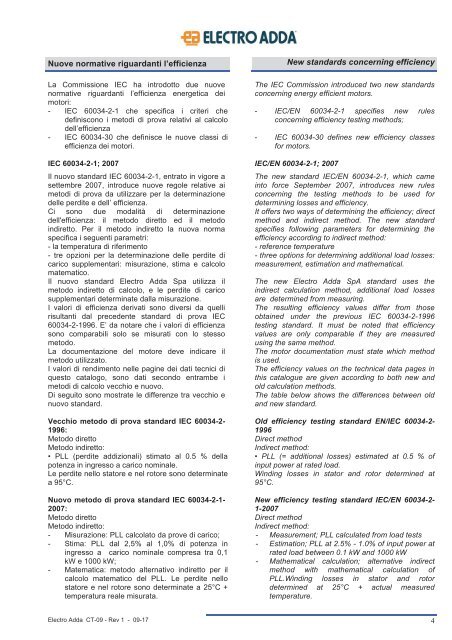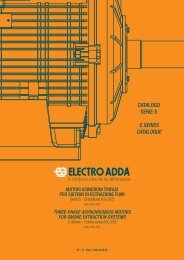You also want an ePaper? Increase the reach of your titles
YUMPU automatically turns print PDFs into web optimized ePapers that Google loves.
Nuove normative riguardanti l’efficienza<br />
La Commissione IEC ha introdotto due nuove<br />
normative riguardanti l’efficienza energetica dei<br />
motori:<br />
- IEC 60034-2-1 che specifica i criteri che<br />
definiscono i metodi di prova relativi al calcolo<br />
dell’efficienza<br />
- IEC 60034-30 che definisce le nuove classi di<br />
efficienza dei motori.<br />
IEC 60034-2-1; 2007<br />
Il nuovo standard IEC 60034-2-1, entrato in vigore a<br />
settembre 2007, introduce nuove regole relative ai<br />
metodi di prova da utilizzare per la determinazione<br />
delle perdite e dell’ efficienza.<br />
Ci sono due modalità di determinazione<br />
dell'efficienza: il metodo diretto ed il metodo<br />
indiretto. Per il metodo indiretto la nuova norma<br />
specifica i seguenti parametri:<br />
- la temperatura di riferimento<br />
- tre opzioni per la determinazione delle perdite di<br />
carico supplementari: misurazione, stima e calcolo<br />
matematico.<br />
Il nuovo standard Electro Adda Spa utilizza il<br />
metodo indiretto di calcolo, e le perdite di carico<br />
supplementari determinate dalla misurazione.<br />
I valori di efficienza derivati sono diversi da quelli<br />
risultanti dal precedente standard di prova IEC<br />
60034-2-1996. E’ da notare che i valori di efficienza<br />
sono comparabili solo se misurati con lo stesso<br />
metodo.<br />
La documentazione del motore deve indicare il<br />
metodo utilizzato.<br />
I valori di rendimento nelle pagine dei dati tecnici di<br />
questo catalogo, sono dati secondo entrambe i<br />
metodi di calcolo vecchio e nuovo.<br />
Di seguito sono mostrate le differenze tra vecchio e<br />
nuovo standard.<br />
Vecchio metodo di prova standard IEC 60034-2-<br />
1996:<br />
Metodo diretto<br />
Metodo indiretto:<br />
• PLL (perdite addizionali) stimato al 0.5 % della<br />
potenza in ingresso a carico nominale.<br />
Le perdite nello statore e nel rotore sono determinate<br />
a 95°C.<br />
Nuovo metodo di prova standard IEC 60034-2-1-<br />
2007:<br />
Metodo diretto<br />
Metodo indiretto:<br />
- Misurazione: PLL calcolato da prove di carico;<br />
- Stima: PLL dal 2,5% al 1,0% di potenza in<br />
ingresso a carico nominale compresa tra 0,1<br />
kW e 1000 kW;<br />
- Matematica: metodo alternativo indiretto per il<br />
calcolo matematico del PLL. Le perdite nello<br />
statore e nel rotore sono determinate a 25°C +<br />
temperatura reale misurata.<br />
New standards concerning efficiency<br />
The IEC Commission introduced two new standards<br />
concerning energy efficient motors.<br />
- IEC/EN 60034-2-1 specifies new rules<br />
concerning efficiency testing methods;<br />
- IEC 60034-30 defines new efficiency classes<br />
for motors.<br />
IEC/EN 60034-2-1; 2007<br />
The new standard IEC/EN 60034-2-1, which came<br />
into force September 2007, introduces new rules<br />
concerning the testing methods to be used for<br />
determining losses and efficiency.<br />
It offers two ways of determining the efficiency; direct<br />
method and indirect method. The new standard<br />
specifies following parameters for determining the<br />
efficiency according to indirect method:<br />
- reference temperature<br />
- three options for determining additional load losses:<br />
measurement, estimation and mathematical.<br />
The new Electro Adda SpA standard uses the<br />
indirect calculation method, additional load losses<br />
are determined from measuring.<br />
The resulting efficiency values differ from those<br />
obtained under the previous IEC 60034-2-1996<br />
testing standard. It must be noted that efficiency<br />
values are only comparable if they are measured<br />
using the same method.<br />
The motor documentation must state which method<br />
is used.<br />
The efficiency values on the technical data pages in<br />
this catalogue are given according to both new and<br />
old calculation methods.<br />
The table below shows the differences between old<br />
and new standard.<br />
Old efficiency testing standard EN/IEC 60034-2-<br />
1996<br />
Direct method<br />
Indirect method:<br />
• PLL (= additional losses) estimated at 0.5 % of<br />
input power at rated load.<br />
Winding losses in stator and rotor determined at<br />
95°C.<br />
New efficiency testing standard IEC/EN 60034-2-<br />
1-2007<br />
Direct method<br />
Indirect method:<br />
- Measurement; PLL calculated from load tests<br />
- Estimation; PLL at 2.5% - 1.0% of input power at<br />
rated load between 0.1 kW and 1000 kW<br />
- Mathematical calculation; alternative indirect<br />
method with mathematical calculation of<br />
PLL.Winding losses in stator and rotor<br />
determined at 25°C + actual measured<br />
temperature.<br />
Electro Adda CT-09 - Rev 1 - 09-17 4






